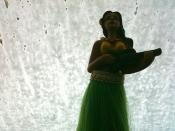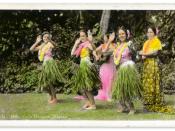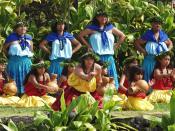Many people believe that there is no difference between hula and ori Tahiti dancing. The common misconception may have come from the fact that both dances came from the Polynesian islands, which is made up of several different islands including Hawaii, Samoa, Fiji, New Zealand, Easter Island, Tahiti, and many more. Although, both came from the same chain of islands, hula originated from Hawaii and ori Tahiti dancing originated Tahiti. Besides having a different origin, they each have their own creation stories, dance styles, costumes, and musical instruments.
Hula dancing originated when Pele, the Hawaiian goddess of fire, told her sister Laka to dance. Since then, schools have been made in honor of Laka, the goddess of hula. According to Hula Moons by Don Blanding (103), dancers would chant, "Oh, Laka, Goddess of the hula. Give suppleness to the bodies of the dancers. Let their feet be quick; Let their hands find the grace of flying birds," before dancing.
During the early 1800's, everybody lost their chance to enjoy the hula as a result of missionary arrival on the Hawaiian Islands. The missionaries thought of hula as a pagan act and banned it. However, the last king of Hawaii, David Kalakaua, brought back hula and the old Hawaiian customs after he said, "Hula is the language of the heart and therefore the heartbeat of the people."
In Tahiti, there was a group called Arioi who dances in honor of Oro, the god of peace. Like hula, it was banned when the missionaries arrived. It wasn't until the late 19th century that ori Tahiti dancing was restored. By that time, ori Tahiti dancing already lost most of the poetry that accompanies the dances, and is now more focused on hip movement to the powerful beats of the drums. It also...


